Biology
Biology concepts ? body plan, bilateral symmetry, cephalization, form follows function
Now for our exception. One animal has abandoned the move toward symmetry in order to improve its ability to hear. Owls are truly more interested in substance over style; they break the rule of symmetry in order to survive. Nocturnal owls must be able to locate their prey in the dark, and for this they rely on their hearing more than sight, so their auditory sense is truly a survival mechanism.
- The Eyes Have It
Biology concepts ? asymmetry, lateral polymorphism, flatfish, evolution, copepod, ecology, niche Ray Harryhausen was the most famous of the stop motion artists in the movies. This version of the Cyclops was his creation for the 1958 movie, The 7th...
- Mirroring Evolution
Biology concepts ? bilateral symmetry, radial symmetry, planulozoa hypothesis, cephalization, last animal common ancestor, porifera, platyhelminth, cnidarian, echinodermata Halloween was a classic slasher film. Jamie Lee Curtis looks so young, decades...
- Let's Get Loud
Biology concepts ? vocalizations, mechanical sounds, sonar, decibels, stridulation Today it seems that truth is more complex than ever. van Goethe was a German statesman and a very successful writer. He wrote novels, scientific treatises, lyric poems,...
- Sneaking Up On A Snake
Biology concepts ? thermosensor, sight-hunters, snake hearing, mutation, TRPA1, pit vipers We have been talking about taste sense for many weeks. I remember a 1975 movie called, A Boy And His Dog, starring a very young Don Johnson. It was a...
- Why Does Your Telephone Have Two Holes? ? Perspective On Our Senses
We all know that we have five senses: seeing, hearing, tasting, touching, and smelling. Anyone disagree? Wanna put some money on it? @font-face { font-family: "Cambria"; }p.MsoNormal, li.MsoNormal, div.MsoNormal { margin: 0in 0in 0.0001pt; font-size:...
Biology
Do You Have Be Ugly to Hear Well? ? Owls and Body Plan Symmetry
Biology concepts ? body plan, bilateral symmetry, cephalization, form follows function
Paradox alert ? the most complex organisms in nature are the best at reducing complexity. How is that? Nature tends toward symmetry through evolution. Lower organisms do not to have much symmetry, while more complex organisms usually have a symmetric body plan.
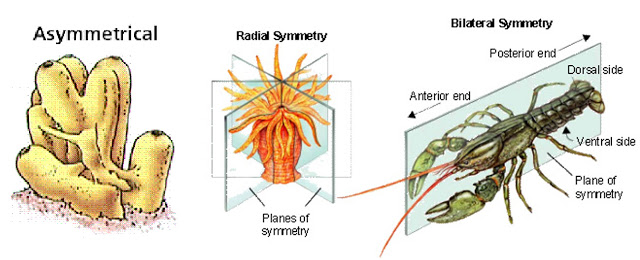 |
| Sponges have no symmetry, some lower animals have radial symmetry, while higher animals (including us) have bilateral symmetry. Bilateral symmetry results in a front end (anterior) and a back end (posterior). |
As far as animals go, sponges have little or no symmetry (yes, sponges are animals). As you move up the ladder of complexity, you first see radial symmetry (starfish, worms, octopuses), then bilateral symmetry (one side of an animal is mirrored by the other side).
Having a mirror image means no additional planning. It?s like building a second building using the plans from the first - no added cost. By repeating units (metamerization, as in worms and arthropods) or mirroring structures in bilateral symmetry, the animal may become more complex, without having a more complex organizational plan and therefore fewer possible mistakes in development. Paradox averted.
Symmetry leads to distinct front and back ends and movement in a certain direction (see the lobster above). This leads to cephalization (development of a head). Cephalization in turn leads to more bilateral symmetry, including of the head itself. The two halves of the face are close to being mirror images.
Bilateral facial symmetry is thought to be important in determining what people think is pretty. Asymmetries in facial characteristics, even if not noticed consciously, may play a role in determining who we believe to be attractive. For example, men with more facial symmetry have more sexual partners and are more likely to have partners outside their primary relationship?.. apparently, symmetry has little to do with decency.
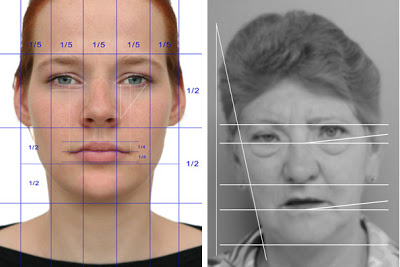 |
The symmetry of different aspects of the face may be a sign of health. |
Facial symmetry might be even more important evolutionarily, as small asymmetries that begin in utero (in the womb) could indicate an inability to resist the harmful effects of environmental or infectious perturbations. This would be a sign of weaker genes and would discourage potential mates. In research on some South American tribes, the more symmetric males tended to have more children survive to adulthood and those children had fewer diseases. It may be that in the search for the healthiest possible mates (therefore the most desirable genes), we use symmetry as a discriminator. Modern medicine has made much of this moot, but instinct is hard to kill.
Now for our exception. One animal has abandoned the move toward symmetry in order to improve its ability to hear. Owls are truly more interested in substance over style; they break the rule of symmetry in order to survive. Nocturnal owls must be able to locate their prey in the dark, and for this they rely on their hearing more than sight, so their auditory sense is truly a survival mechanism.
To hear a mouse, or a ferret, or a cheeseburger from a long distance away is one thing, but owls also need pinpoint from where that sound is coming. Many animals (including humans and owls) are capable of detecting small differences in the time that sounds reach each ear. This is one of the beauties of bilateral symmetry - we have two ears.
If a sound originates from your left, it reaches your left ear before it reaches your right. Your brain senses this time difference and calculates how far left of center the object must be. Humans and owls are equally good at this; we can detect a time difference of less than 10 millionths of a second (0.00001 sec)! In addition, if the sound is closer to your left ear, the sound reaching it will be just a little louder than the sound reaching your right ear. Your brain can sense this difference as well.
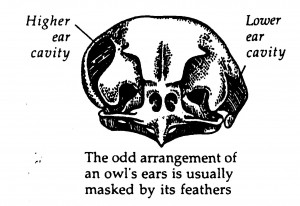 |
| There is a large disparity in the vertical position of the ears in many species of owls. Does it make them unfit or ugly? |
However, owls take this a step further, since the third dimension is of more importance in their world. Owls need to know if their prey is above or below them (and by how much) in order to hunt efficiently. With ears at the same height, a sound from below or above reaches both ears at the same time ? no help in locating dinner.
On the other hand, if the ears were located at different heights, the sound would reach one ear before the other, and locality information could be obtained. This is what evolution has done for many species of owl. Perhaps not the prettiest solution, but beautiful none-the-less.
Looking at the picture of the owl skull, you can see that the right ear operculum (opening) is placed well above that of the left. This asymmetry does wonders for their sense of hearing, but leaves them with a lopsided head. Lucky for their love life, most owls? head and facial feathers tend to even out this disparity.
The ear asymmetry isn?t the owl?s only body design modification. The combination of the elements listed below allows owls to hear a mouse burrowing under six inches snow up to 100 ft. away, or hear it squeak from a half mile away! It would seem that owls are designed to pick up noise.
Head turn ? The asymmetry of the ears and their location on each side of the head allow the owl to localize the sound to a certain degree, but it is increased by the owl turning its head from side to side. The head position where the sound reaches the owls ears at the same time defines when the prey directly in front of its nose. The owl can do this without moving because of its extraordinary ability to turn its head 270 degrees in either direction. This would mean that you could turn your head to the right and end up looking at your left shoulder!
Facial disk ? In general, the bigger the facial disk on an owl, the more it relies on hearing as opposed to sight to locate prey. The disk is shaped to collect sound and funnel it toward the ears, much the same way that our outer ears collect sound for us, or how a satellite dish collects TV signals.
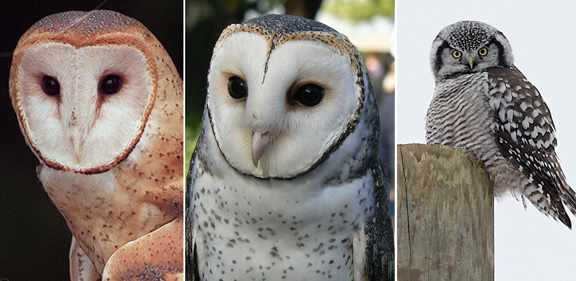 |
The size of the facial disk on an owl gives you an idea how much it relies on hearing to catch its prey. The barn owl on the left and the masked owl in the center rely on hearing most, while the Northern Hawk Owl on the right uses primarily its eyes to hunt. |
An owl?s facial muscles change the shape of the facial disk in order to fine tune the sound entering the ears and better locate prey. This is an important hint as to the importance of hearing in some owls; they have muscles to change the shape of their sound collecting face, yet they can?t move their eyes.
Spatial auditory mapping - The signals relating to where a sound is coming from are coordinated in the owl?s medulla (an old area of the brain). This part of an owl?s brain is three times as large as a crow?s, and hints that something special may be going on there. The up and down location information generated by the asymmetry of the ear positions is integrated with the left and right information generated from the ear positions on the side of the head and the head turn. The distance is also estimated by the time and intensity differences of sound wave arrival, especially as the head is turned.
For asymmetric owls, the left-right directional cues lie in the interaural (inter = between, and aural = ears) time difference (ITD), while elevation cues are processed via interaural level (loudness) differences (ILD). These two cues are processed in different parts of the brain and then converge to form an aural map. A recent study has compared the size of the auditory nuclei and evolution of these nuclei in asymmetrical- and symmetrical-eared owls.
The Canadian research team found that all auditory nuclei in asymmetrically-eared owls are larger than the same nuclei in symmetrically-eared owls, even those not involved in ILD, ITD, or converging of signals. They hypothesize that the enlarged nuclei result in increased locating abilities, but also in an extended hearing range in asymmetrically-eared owls. Comparison between phylogenetic trees indicates that increased locating ability preceded an increase in hearing range, and that they both have arisen more than once in different groups.
For asymmetric owls, the left-right directional cues lie in the interaural (inter = between, and aural = ears) time difference (ITD), while elevation cues are processed via interaural level (loudness) differences (ILD). These two cues are processed in different parts of the brain and then converge to form an aural map. A recent study has compared the size of the auditory nuclei and evolution of these nuclei in asymmetrical- and symmetrical-eared owls.
The Canadian research team found that all auditory nuclei in asymmetrically-eared owls are larger than the same nuclei in symmetrically-eared owls, even those not involved in ILD, ITD, or converging of signals. They hypothesize that the enlarged nuclei result in increased locating abilities, but also in an extended hearing range in asymmetrically-eared owls. Comparison between phylogenetic trees indicates that increased locating ability preceded an increase in hearing range, and that they both have arisen more than once in different groups.
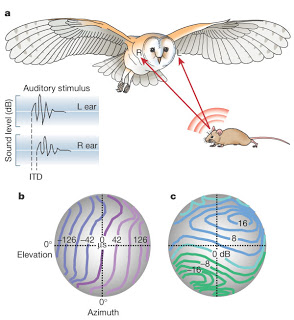 |
Since the sound reaches the ears with different qualities, the owl can map the sound to a position in his visual field, based on time differences (panel b) and intensity differences (panel c). This position is mapped directly on to the owl?s visual map. |
All this sound information is then translated onto the owl?s visual map in its brain (the location of objects in space as the owl sees it ? most mammals have one of these). The owl actually sees the position of the sound, as if the little mouse?s voice was a big red flag waving at the owl. This auditory and visual cooperation must be important for owls, because when they go blind early in life, owls can no longer hunt by sound.
In each example above, the owl has manifested a functional ability, and in each instance this ability has been honed to increase that function. The form may not be elegant, it may not be easy, it may break a rule of biology, but it must be the way it is to perform its function. This is a basic tenet of biology ? form follows function. How something looks is more related to its job rather than to the overall esthetics or appeal of the organism. That is why it is so easy for organisms to break rules ? function sometimes demands it. Owls are built for hearing, and as a result, they look like owls. Amazing?..and beautiful.
Gutiérrez-Ibáñez, C., Iwaniuk, A., & Wylie, D. (2011). Relative Size of Auditory Pathways in Symmetrically and Asymmetrically Eared Owls Brain, Behavior and Evolution, 78 (4), 286-301 DOI: 10.1159/000330359
Gutiérrez-Ibáñez, C., Iwaniuk, A., & Wylie, D. (2011). Relative Size of Auditory Pathways in Symmetrically and Asymmetrically Eared Owls Brain, Behavior and Evolution, 78 (4), 286-301 DOI: 10.1159/000330359
For more information, classroom activities and laboratories, see:
Body plan ?
http://userwww.sfsu.edu/~biol240/labs/lab_16animalbodyplan/pages/bodyplan.html
http://faculty.clintoncc.suny.edu/faculty/michael.gregory/files/bio 102/bio 102 lectures/animal diversity/lower invertebrates/sponges.htm
http://intro.bio.umb.edu/111-112/112s99Lect/bodyplans/sponge.html
http://userwww.sfsu.edu/~biol240/labs/lab_16animalbodyplan/index.html
http://evolution.berkeley.edu/evolibrary/article/arthropods_04
http://illuminations.nctm.org/LessonDetail.aspx?ID=L471
http://www.emc.maricopa.edu/faculty/farabee/biobk/biobookdiversity_7.html
http://www.misterteacher.com/symmetry.html
http://edhelper.com/ReadingComprehension_54_56.html
www.pbs.org/kcet/shapeoflife/resources/activity5.pdf
http://people.hsc.edu/faculty-staff/edevlin/edsweb01/new_page_12.htm
cephalization ?
http://faculty.clintoncc.suny.edu/faculty/michael.gregory/files/bio%20102/bio%20102%20lectures/nervous%20system/nervous1.htm
http://universe-review.ca/R10-33-anatomy.htm
http://evolution.berkeley.edu/evolibrary/article/evo_54
http://biology--dev.nebrwesleyan.edu/Courses/Labs/Biology_of_Animals/ZooLab4/Cephalization_Quiz.html
http://www.biologycorner.com/worksheets/articles/dugesia.html
http://www.apple.dreab.com/p-Cephalization
owl hearing ?
http://www.owlpages.com/articles.php?section=Owl+Physiology&title=Hearing
http://www.sciencedaily.com/releases/2007/08/070801091509.htm
http://www.bocn.org/factfile_detail.asp?id=39
http://www.stanford.edu/group/stanfordbirds/text/essays/How_Owls_Hunt.html
http://www.hhmi.org/senses/c220.html
http://islandwood.org/forkids/owls-at-islandwood/how-can-we-see-owls/owl-ears-1/asymmetrical-ears
- The Eyes Have It
Biology concepts ? asymmetry, lateral polymorphism, flatfish, evolution, copepod, ecology, niche Ray Harryhausen was the most famous of the stop motion artists in the movies. This version of the Cyclops was his creation for the 1958 movie, The 7th...
- Mirroring Evolution
Biology concepts ? bilateral symmetry, radial symmetry, planulozoa hypothesis, cephalization, last animal common ancestor, porifera, platyhelminth, cnidarian, echinodermata Halloween was a classic slasher film. Jamie Lee Curtis looks so young, decades...
- Let's Get Loud
Biology concepts ? vocalizations, mechanical sounds, sonar, decibels, stridulation Today it seems that truth is more complex than ever. van Goethe was a German statesman and a very successful writer. He wrote novels, scientific treatises, lyric poems,...
- Sneaking Up On A Snake
Biology concepts ? thermosensor, sight-hunters, snake hearing, mutation, TRPA1, pit vipers We have been talking about taste sense for many weeks. I remember a 1975 movie called, A Boy And His Dog, starring a very young Don Johnson. It was a...
- Why Does Your Telephone Have Two Holes? ? Perspective On Our Senses
We all know that we have five senses: seeing, hearing, tasting, touching, and smelling. Anyone disagree? Wanna put some money on it? @font-face { font-family: "Cambria"; }p.MsoNormal, li.MsoNormal, div.MsoNormal { margin: 0in 0in 0.0001pt; font-size:...
